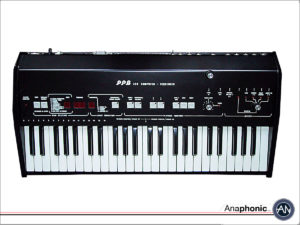Ppg
Palm Products GmbH (commonly abbreviated to PPG) was a highly regarded manufacturer of audio synthesizers. Founded and owned by Wolfgang Palm, PPG was located in Hamburg, Germany and, for 12 years from around 1975 to 1987, manufactured an acclaimed and eclectic range of electronic musical instruments, all designed by Palm. Wolfgang Palm was active as a keyboardist in bands in the Hamburg area before becoming aware of the then-burgeoning synthesizer market. Palm started his company in 1975. Although he had reportedly built many synthesizers on his own, his first commercially available synthesizer was a modular synthesizer, dubbed the 300 Series, which, despite being fairly sophisticated, failed to sell in large quantities. Motivated by his failure and inspired by the design of the popular Minimoog, Palm introduced the 1002 and 1020 synthesizers. Both were portable, analog, monophonic, and relatively compact. The 1002 used voltage-controlled oscillators; however, the 1020 was revolutionary in its implementation of digitally controlled oscillators, which were much more stable and had a distinctive sound that later became PPG’s trademark. After the decline of PPG, Wolfgang Palm continued to be an active innovator in the area of synthesizer technology. For Waldorf Music he designed the digital ASIC for the first Waldorf product Microwave (1989) which basically contained the complete sound engine of the PPG wave 2.2. By 1982, Wolfgang Palm was set on innovating again by introducing computers to music with the Waveterm, a rack-mounted computer system with a built-in monitor, two 8-inch floppy drives (later upgraded to 5.25-inch), and a proprietary Flex9-based operating system running on a Eurocom II motherboard created by the German company Eltec. It was designed to be used with many of PPG’s synthesizers, including the Wave, by specifying points on a graph which was displayed on the screen. One could also sample in acoustic sounds, or use some sounds provided by PPG on disks. PPG officially ceased business operations and closed its doors in 1987. After the decline of PPG, Wolfgang Palm continued to be an active innovator in the area of synthesizer technology. For Waldorf Music he designed the digital ASIC for the first Waldorf product Microwave (1989) which basically contained the complete sound engine of the PPG wave 2.2. The later Waldorf products like the MicroWave II, XT, Q, microQ, Blofeld all had all or several of the original wavetables and waveshapes of the PPG Waves. Palm’s influence on synthesis and electronic music is, undoubtedly, tremendous. The PPG wave’s unique sound, and its use on the recordings of such a diverse range of artists is, arguably, responsible for the rise in popularity of digital synthesis in the late 1980s and early 1990s, till today.
Showing all 12 results












